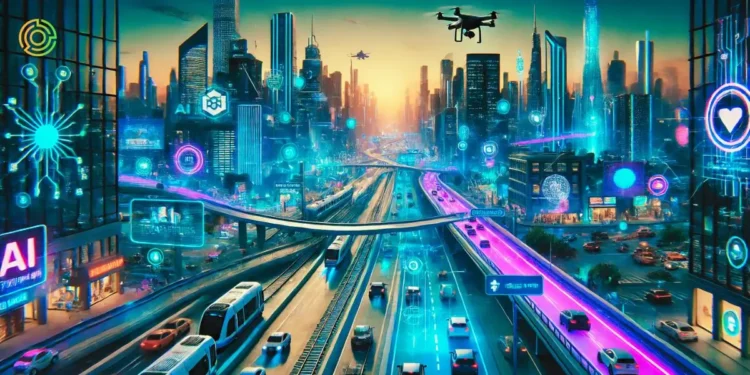As urban populations continue to grow, cities around the world face increasing challenges related to traffic congestion, pollution, and public transportation efficiency. To address these issues, many smart cities are turning to AI in transportation, leveraging artificial intelligence to create more efficient, sustainable, and safe mobility solutions. But how exactly is AI-powered transportation shaping the future of urban living? In this article, we will explore the key areas where artificial intelligence in transportation is making a significant impact and what the future holds for these technologies.
The rise of AI in Transportation
The integration of artificial intelligence in transportation is rapidly transforming how cities manage traffic, logistics, and public transit systems. AI in logistics and transportation is not only optimizing routes and reducing costs but also enhancing safety and improving user experiences. For example, AI in traffic management is helping reduce congestion by predicting traffic flow patterns, while AI for transportation safety is enabling more accurate incident detection and prevention.
But what are the most compelling applications of AI-driven transportation solutions, and how do they contribute to the development of smart cities?
AI-Powered urban traffic management: Tackling congestion
One of the most pressing problems in urban areas is traffic congestion. AI-powered transportation systems can analyze vast amounts of data in real-time to provide more efficient traffic control and prediction. AI-based traffic control uses machine learning algorithms to optimize the timing of traffic lights, minimizing wait times and reducing fuel consumption.
AI in Traffic Prediction and management
AI in traffic prediction allows cities to anticipate congestion before it happens. By analyzing historical data and real-time sensor inputs, AI can forecast where and when traffic bottlenecks will occur. This information can then be used to adjust traffic signals or suggest alternative routes for drivers, significantly improving overall traffic flow.
Have you ever been stuck in traffic wondering if there’s a better way? With AI-driven transportation systems, these frustrating moments could be a thing of the past.
Smart traffic lights
One of the most successful implementations of AI in traffic management is smart traffic lights. These systems adapt their timing based on current traffic conditions rather than fixed schedules. For example, during off-peak hours, traffic lights could stay green longer in one direction if sensors detect minimal cross-traffic. AI sensors in transportation play a critical role in making this possible by providing real-time data that helps traffic systems adapt dynamically.
AI in Public Transportation: A path to efficiency
Public transportation is a key element of any smart city, and AI is playing a transformative role in improving service quality and efficiency. AI for public transportation helps transit authorities optimize routes, reduce wait times, and manage fleets more effectively. It also plays a vital role in real-time scheduling and providing commuters with accurate arrival times.
AI in fleet management
AI in fleet management is revolutionizing the way public transit and delivery companies monitor their vehicles. By using AI to track vehicle conditions, fuel consumption, and maintenance needs, companies can reduce operational costs and prevent breakdowns. Predictive maintenance in transportation ensures that vehicles are serviced before issues arise, which is crucial for maintaining reliable public transit systems.
AI for route optimization
AI’s ability to process vast amounts of data allows it to optimize routes based on traffic, weather, and even user demand. AI for route optimization is particularly useful in logistics and delivery services, but its benefits extend to public transportation as well. By optimizing bus and train routes, cities can reduce delays and provide a more reliable service.
What impact could reliable public transportation have on your daily commute? With AI in improving public transit efficiency, commuters can expect fewer delays and more convenient service schedules.
Autonomous Transportation: The future of urban mobility
One of the most exciting applications of AI in transportation is the development of autonomous vehicles. These self-driving cars, trucks, and buses promise to revolutionize urban mobility by reducing accidents, improving fuel efficiency, and freeing up human drivers for other tasks.
AI in Self-Driving cars
AI in self-driving cars uses advanced machine learning models, such as deep learning in transportation, to interpret data from cameras, LIDAR, and radar systems, allowing vehicles to navigate safely. As cities continue to evolve, AI for vehicle navigation will be critical to the success of autonomous transportation systems.
Connected vehicles and AI
Connected vehicles AI refers to the integration of autonomous vehicles into a larger, interconnected network. These vehicles will communicate with each other and with urban infrastructure, making real-time decisions to avoid accidents and optimize traffic flow. This will be a key feature of future AI in smart cities transportation systems.
AI for Transportation safety: Reducing accidents and improving public safety
In addition to enhancing efficiency, AI is also transforming safety in transportation. From AI transportation safety systems in cars to AI sensors in transportation infrastructure, technology is being used to reduce accidents and improve response times in emergencies.
AI in Transport safety systems
AI in transport safety systems uses predictive analytics to identify potential hazards before they lead to accidents. For example, AI can monitor driver behavior to detect fatigue or distraction, preventing accidents before they occur. Additionally, AI for transportation safety improvement ensures that vehicles and infrastructure are maintained properly, reducing the likelihood of mechanical failures.
Predictive maintenance and safety
Predictive maintenance in transportation is another critical area where AI is making a difference. By monitoring vehicle health in real time, AI systems can predict when parts will fail and schedule maintenance accordingly. This reduces the risk of accidents caused by mechanical failure, ensuring that public transportation remains safe for passengers.
Do you feel safer knowing that AI in transport safety systems is monitoring vehicles and infrastructure to prevent accidents?
AI and sustainability in Transportation
One of the most promising aspects of AI in transportation is its potential to create more sustainable cities. By reducing fuel consumption, improving traffic flow, and optimizing public transit, AI can help cities lower their carbon footprints.
AI for fuel efficiency
AI for fuel efficiency uses data from sensors to optimize how vehicles use fuel. This is particularly useful for large fleets of buses or trucks, where even small improvements in fuel efficiency can lead to significant cost savings and environmental benefits.
AI for Transportation cost reduction
By reducing traffic congestion and optimizing routes, AI can also lead to significant cost savings for cities and companies. AI for transportation cost reduction allows businesses to lower their operational expenses, which can lead to more affordable and efficient public transit services for city residents.
Challenges and ethical concerns of AI in Transportation
While AI in transportation offers many benefits, it also presents several challenges. From data privacy concerns to the risk of job displacement, the rapid adoption of AI raises ethical and regulatory questions.
AI Transportation challenges
One of the biggest challenges is ensuring that AI systems are fair and unbiased. AI transportation ethical concerns also include the potential for accidents caused by autonomous vehicles and the accountability for those accidents. As AI becomes more integrated into everyday transportation, cities must develop AI in transportation regulations to govern its use.
Security and privacy in AI Transportation
The widespread use of AI also raises concerns about data security and privacy. Security and privacy in AI transportation systems need to be prioritized to ensure that personal information and location data are protected from cyberattacks.
The future of AI in Transportation
The future of AI in transportation is incredibly promising. As technology continues to evolve, we can expect to see even more advanced applications in autonomous vehicles, public transportation, and logistics. The growth of AI in urban mobility will play a key role in shaping the future of smart cities around the world.
AI in Transportation industry trends
The AI transportation market forecast shows significant growth in the coming years, with experts predicting that the global AI in transportation market could reach $23.11 billion by 2032. As more cities adopt AI transportation innovations, we’ll see improvements in traffic flow, public transit, and environmental sustainability.
Are you excited about the potential of AI in transportation to make your daily commute smoother and more efficient?
Conclusion
As we’ve seen, AI in transportation is revolutionizing how cities manage traffic, logistics, and public transit. From AI-powered traffic management to autonomous vehicles and smart transportation systems, the future of urban mobility is being shaped by artificial intelligence. While challenges remain, the potential benefits of AI-driven transportation—including reduced congestion, improved safety, and enhanced sustainability—are undeniable.
What do you think the most significant benefit of AI in transportation will be? Share your thoughts in the comments and join the conversation!
FAQs
How is AI used in transport?
AI in transport is used to optimize traffic flow, predict congestion, manage public transit schedules, and improve safety through predictive maintenance and real-time monitoring systems.
How is AI used in vehicles?
AI is used in autonomous vehicles, driver assistance systems, and for predictive maintenance to monitor vehicle health and prevent breakdowns.
How is AI used in the travel industry?
AI in the travel industry is used for route optimization, predictive analytics for traffic and demand, and enhancing customer experiences through chatbots and personalization.
What are the problems with AI in transportation?
Some challenges include data privacy concerns, ethical questions around autonomous vehicle accidents, and the potential for job displacement in sectors like public transportation and logistics.
Twitter Linkedin Facebook Telegram Instagram Google News Amazon Store












































